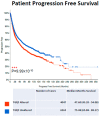At the Intersection of Cardiology and Oncology: TGFβ as a Clinically Translatable Therapy for TNBC Treatment and as a Major Regulator of Post-Chemotherapy Cardiomyopathy
- PMID: 35326728
- PMCID: PMC8946238
- DOI: 10.3390/cancers14061577
At the Intersection of Cardiology and Oncology: TGFβ as a Clinically Translatable Therapy for TNBC Treatment and as a Major Regulator of Post-Chemotherapy Cardiomyopathy
Abstract
Triple-negative breast cancer (TNBC) is a subtype of breast cancer that accounts for the majority of breast cancer-related deaths due to the lack of specific targets for effective treatments. While there is immense focus on the development of novel therapies for TNBC treatment, a persistent and critical issue is the rate of heart failure and cardiomyopathy, which is a leading cause of mortality and morbidity amongst cancer survivors. In this review, we highlight mechanisms of post-chemotherapeutic cardiotoxicity exposure, evaluate how this is assessed clinically and highlight the transforming growth factor-beta family (TGF-β) pathway and its significance as a mediator of cardiomyopathy. We also highlight recent findings demonstrating TGF-β inhibition as a potent method to prevent cardiac remodeling, fibrosis and cardiomyopathy. We describe how dysregulation of the TGF-β pathway is associated with negative patient outcomes across 32 types of cancer, including TNBC. We then highlight how TGF-β modulation may be a potent method to target mesenchymal (CD44+/CD24-) and epithelial (ALDHhigh) cancer stem cell (CSC) populations in TNBC models. CSCs are associated with tumorigenesis, metastasis, relapse, resistance and diminished patient prognosis; however, due to plasticity and differential regulation, these populations remain difficult to target and continue to present a major barrier to successful therapy. TGF-β inhibition represents an intersection of two fields: cardiology and oncology. Through the inhibition of cardiomyopathy, cardiac damage and heart failure may be prevented, and through CSC targeting, patient prognoses may be improved. Together, both approaches, if successfully implemented, would target the two greatest causes of cancer-related morbidity in patients and potentially lead to a breakthrough therapy.
Keywords: CSC; TNBC TGF-β; cardiology; oncology.
Conflict of interest statement
The authors declare no conflict of interest.
Figures


Similar articles
-
Clinically Translatable Approaches of Inhibiting TGF-β to Target Cancer Stem Cells in TNBC.Biomedicines. 2021 Oct 4;9(10):1386. doi: 10.3390/biomedicines9101386. Biomedicines. 2021. PMID: 34680503 Free PMC article. Review.
-
Dual inhibition of Wnt and Yes-associated protein signaling retards the growth of triple-negative breast cancer in both mesenchymal and epithelial states.Mol Oncol. 2018 Apr;12(4):423-440. doi: 10.1002/1878-0261.12167. Epub 2018 Feb 21. Mol Oncol. 2018. PMID: 29316250 Free PMC article.
-
CSCs in Breast Cancer-One Size Does Not Fit All: Therapeutic Advances in Targeting Heterogeneous Epithelial and Mesenchymal CSCs.Cancers (Basel). 2019 Aug 7;11(8):1128. doi: 10.3390/cancers11081128. Cancers (Basel). 2019. PMID: 31394796 Free PMC article. Review.
-
Targeting CD73 with flavonoids inhibits cancer stem cells and increases lymphocyte infiltration in a triple-negative breast cancer mouse model.Front Immunol. 2024 Mar 27;15:1366197. doi: 10.3389/fimmu.2024.1366197. eCollection 2024. Front Immunol. 2024. PMID: 38601156 Free PMC article.
-
TGF-β inhibition enhances chemotherapy action against triple-negative breast cancer.J Clin Invest. 2013 Mar;123(3):1348-58. doi: 10.1172/JCI65416. Epub 2013 Feb 8. J Clin Invest. 2013. PMID: 23391723 Free PMC article.
Cited by
-
MBNL2 promotes aging-related cardiac fibrosis via inhibited SUMOylation of Krüppel-like factor4.iScience. 2024 Jun 3;27(7):110163. doi: 10.1016/j.isci.2024.110163. eCollection 2024 Jul 19. iScience. 2024. PMID: 38974966 Free PMC article.
References
-
- Bauer K.R., Brown M., Cress R.D., Parise C.A., Caggiano V. Descriptive analysis of estrogen receptor (ER)-negative, progesterone receptor (PR)-negative, and HER2-negative invasive breast cancer, the so-called triple-negative phenotype: A population-based study from the California cancer Registry. Cancer. 2007;109:1721–1728. doi: 10.1002/cncr.22618. - DOI - PubMed
-
- Tan C., Denlinger C. Cardiovascular toxicity in cancer survivors: Current guidelines and future directions. Am. Coll. Cardiol. Expert Anal. 2018;29
Publication types
LinkOut - more resources
Full Text Sources
Miscellaneous

